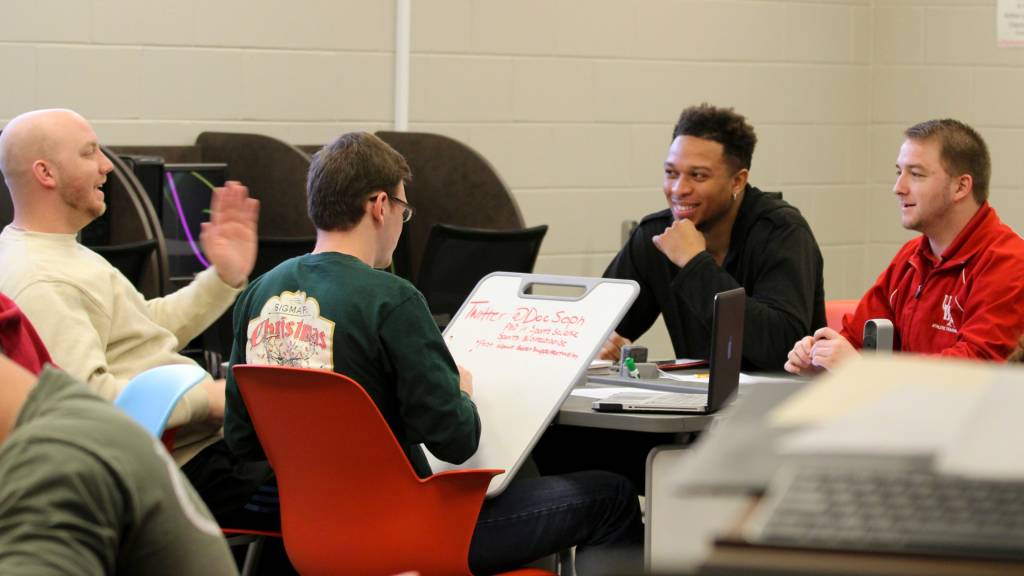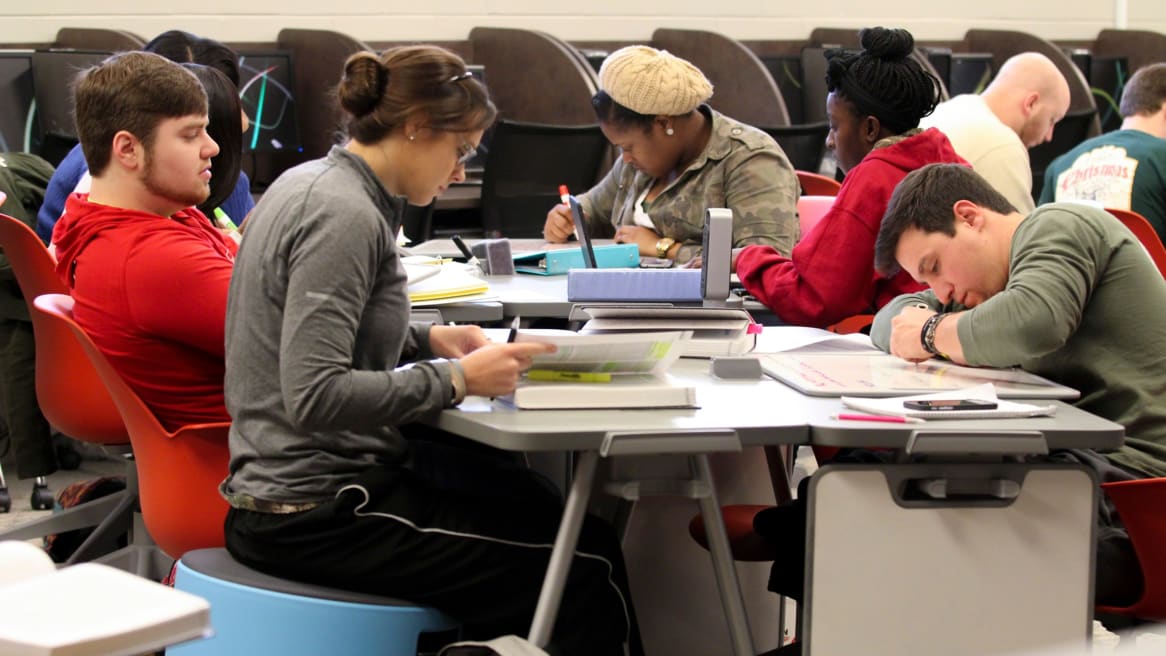Teaching Tomorrow’s Teachers through Active Learning
The University of West Alabama used the Steelcase Education Active Learning Center Grant to engage students and faculty to learn in new ways.
Recent research from Dell Technologies and the Institute for the Future estimates 85 percent of jobs being done by students in 2030 have yet to be invented. Educators are challenged with preparing students for jobs they can’t imagine. But, who is preparing the teachers? The University of West Alabama, a campus of more than 5,000 students situated in Livingston, about two-and-a-half hours west of Montgomery, awards more education graduate degree certifications than any other institution in Alabama.
The university serves a region that is both at an economic and educational disadvantage. In 2015, 11 of the state’s 56 failing schools were located in six of the nine counties the school is specifically targeting. These counties are among the poorest in Alabama and high school dropout rates are as high as 20 percent. Many who make it to college are first-generation students requiring remedial courses in math, English or both. The university is committed to retaining its own students who may find college overwhelming. And, by graduating future teachers, UWA is helping to prepare future college students as well.
ACTIVE LEARNING CENTER GRANT
Browse resources, sign up for updates and learn more about Steelcase Education’s Active Learning Center Grant.
Who’s Teaching Our Teachers?
Celeste A. Wheat, Ph.D., serves as assistant professor of student affairs at UWA. She remembers the teacher who helped chart her life’s course. During a break in one of her undergraduate courses, the professor pulled Wheat aside and told her she could get a graduate degree and teach others in a college setting. Her mentor, a professor and currently Vice Provost for Academic Affairs at the University of Southern Mississippi, had taken the time to get to know her and give her informed council. These days, Wheat is constantly searching for ways to do the same by boosting student engagement and helping them find their passions. She is responsible for starting the Center for Excellence in Teaching, Learning and Leading (CETLL) at UWA.
When Wheat first arrived at UWA, she found another mentor in Martha Hocutt, Ph.D., now professor emeritus. From a family of educators, Hocutt never planned on being a teacher. But, as her kids grew, she started teaching their Sunday school class. They hated going and she knew there were ways to make that time more enjoyable. Soon, other parents were telling her to become a teacher and so began a career that has lasted three decades.
Active Learning Pedagogy
When Wheat joined UWA, faculty like Hocutt were operating with an agreed upon 5E (engage, explore, explain, elaborate, evaluate) model lesson plan. Wheat eagerly adopted more innovative teaching methods and immediately noticed a difference in her classes. But, she ran into barriers as she continued to use these active learning techniques. It was difficult to have her classes gather for a brief bit of instruction at the beginning of class and then break apart into smaller groups. Fixed furniture meant that if she walked around or held a class discussion, someone was always looking at someone else’s back.
Active Learning Center Grant
When the UWA graduate dean alerted her to the Steelcase Education Active Learning Center Grant, she knew it could make a difference in the classroom.
“It’s more important than ever to retain our students, and the key to retaining them is engaging them,” says Wheat. “A cornerstone of our university is our College of Education. It’s a natural fit for us to lead the way in active learning.”
In addition to the Active Learning Center (ALC) Grant, the U.S. Department of Education also awarded UWA a $2.5 million grant to develop a retention center. As a co-primary investigator on the retention center grant, Wheat headed up a key grant priority to create initiatives providing professional development for students aspiring to be future UWA teachers and current K-12 educators in the local region. Both grants position UWA as a leader in teacher development.
After receiving the ALC Grant, UWA partnered with Steelcase Education to finalize classroom installation and conduct initial faculty training. Their new classroom morphs from lecture mode to independent or team work, to presentation, discussion and back again. It includes Node seating which swivels and is height adjustable for enhanced conversations, a Verb instructor station to support a variety of postures and Verb personal whiteboards to enhance displayed thinking.

The university then collected pre and post survey data from the Active Learning Center students to share internally as well as with other educators interested in advancing active learning. The two year analysis of survey data indicated significantly positive effects of the Active Learning Center on improving students’ attention and participation in class.
| Criteria | Active Learning Classroom | Traditional Classroom |
| Students are actively involved in learning activities | 92.3% | 71.4% |
| Instructor gives students opportunity to perform exploration | 76.9% | 28.6% |
| Instructor creates an atmosphere conducive to doing learning activities | 92.3% | 57.1% |
| There is collaborative learning and each student contributes actively to the group | 92.3% | 57.1% |
The Active Learning Classroom plays host to many faculty development activities and education conferences held at UWA. In addition, it’s used as a model classroom to expose future teachers to active learning and inspire them to bring these techniques to their students. For Wheat, the Active Learning Classroom also helped her better connect with her students just like her mentors have connected with her through the years.
“Whenever I put my students in the small group configuration, I get to know them better because I have the ability to physically walk around to them and the time to talk to them. In a large lecture class, it’s much harder for that to happen,” said Wheat. “Now, when they contact me outside of class, it is more personal because I know who they are. I can more easily monitor their progress and follow up with strategies to help them learn.”
Hocutt agrees. She finds the active learning configurations help her learn her students’ capabilities. “Before I’d say, ‘I have a few smart kids in here.’ Now, I see talents emerge from all my students because whether it’s writing, technology, teaching or something else, they can bring them forward in their new environment.”
Applications for the latest cycle of the Active Learning Grant are being accepted from December 1, 2017 until February 2, 2018.


